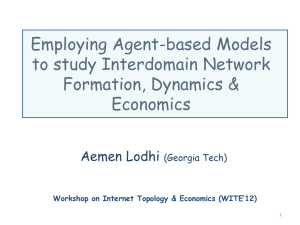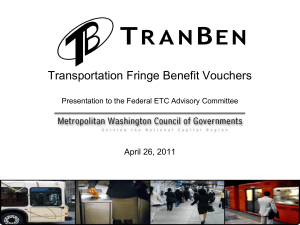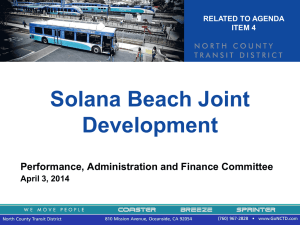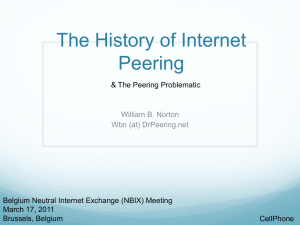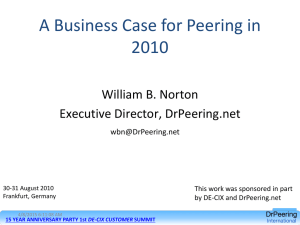pptx
advertisement
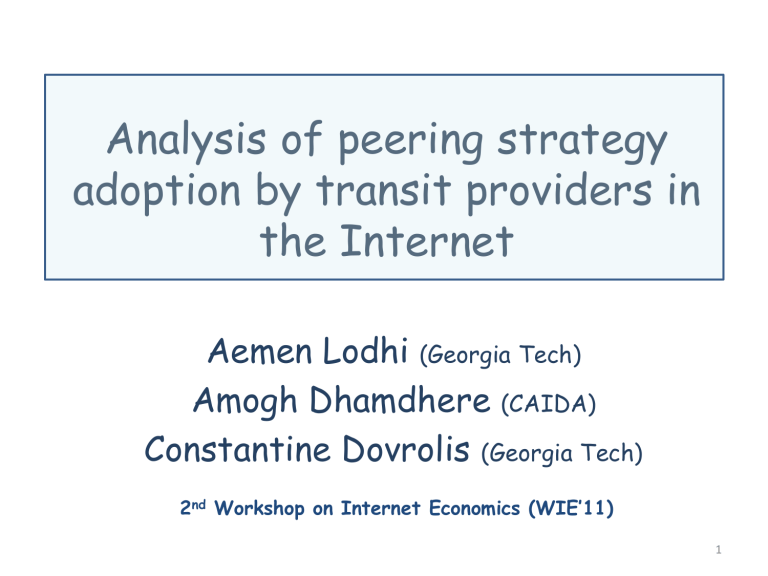
Analysis of peering strategy adoption by transit providers in the Internet Aemen Lodhi (Georgia Tech) Amogh Dhamdhere (CAIDA) Constantine Dovrolis (Georgia Tech) 2nd Workshop on Internet Economics (WIE’11) 1 Outline • • • • Motivation Objective The model: GENESIS Results – Adoption of peering strategies – Impact on economic fitness – Who loses? Who gains? • Alternatives • Conclusion 2 Motivation • Peering strategies of ASes in the Internet (source: PeeringDB www.peeringdb.com) 3 Motivation • Peering policies for networks classified by traffic ratio (source: PeeringDB www.peeringdb.com) 4 Objective • • • • Why do transit providers peer Openly? Impact on their economic fitness? Which transit providers lose/gain? Are their any alternative peering strategies? Internet Transit Provider Enterprise customer Transit Provider Content Provider Content Provider Enterprise customer 5 Approach • Agent based computational modeling • Scenarios Conservative • Selective • Restrictive vs. Non-conservative • Selective • Restrictive • Open The model: GENESIS* • Agent based interdomain network formation model • Incorporates – Co-location constraints in provider/peer selection – Traffic matrix – Public & Private peering – Set of peering strategies – Peering costs, Transit costs, Transit revenue *GENESIS: An agent-based model of interdomain network formation, traffic flow and economics. To appear in InfoCom'12 7 The model: GENESIS* Fitness = Transit Revenue – Transit Cost – Peering cost • Objective: Maximize economic fitness • Optimize connectivity through peer and transit provider selection • Choose the peering strategy that maximizes fitness Peering strategies • Restrictive: Peer only to avoid network partitioning • Selective: Peer with ASes of similar size 𝑉𝑥 ≤𝜎 𝑉𝑦 𝑉𝑥 = 𝑇𝑟𝑎𝑛𝑠𝑖𝑡 + 𝐺𝑒𝑛𝑒𝑟𝑎𝑡𝑒𝑑 + 𝐶𝑜𝑛𝑠𝑢𝑚𝑒𝑑 • Open: Every co-located AS except customers 9 RESULTS 10 Percentage of transit providers Strategy adoption by transit providers 100 90 80 70 60 50 Restrictive 40 Selective 30 Open 20 10 0 Conservative Non-conservative Scenarios 11 Why do transit providers adopt Open peering? Affects: • Transit Cost • Save Transit Revenue transit • Peering costs Cost v x y But your customers are doing the same! z w Why gravitate towards Open peering? x regains lost x adopts Open Options for transit revenue peering x? partially x lost transit revenue z w, traffic passes through x x y Not isolated Y peering openly decisions Network effects !! z w, z z y, traffic bypasses x w Impact on fitness of transit providers switching from Selective to Open • 70% providers have their fitness reduced 14 Fitness components: transit cost, transit revenue, peering cost? • Reduction in transit cost accompanied by loss of transit revenue • 𝑇𝑟𝑎𝑛𝑠𝑖𝑡 𝑐𝑜𝑠𝑡 𝑟𝑎𝑡𝑖𝑜 = 𝑇𝑟𝑎𝑛𝑠𝑖𝑡 𝑐𝑜𝑠𝑡 𝑤𝑖𝑡ℎ 𝑂𝑝𝑒𝑛 𝑇𝑟𝑎𝑛𝑠𝑖𝑡 𝑐𝑜𝑠𝑡 𝑤𝑖𝑡ℎ 𝑆𝑒𝑙𝑒𝑐𝑡𝑖𝑣𝑒 15 Fitness components: transit cost, transit revenue, peering cost? • Significant increase in peering costs • Interplay between transit & peering cost, transit revenue Avoid fitness loss? • Lack of coordination • No incentive to unilaterally withdraw from peering with peer’s customer • Sub-optimal equilibrium x y z w vs. x y z w Which transit providers gain through Open peering? Which lose? • Classification of transit providers – Traffic volume – Customer cone size Percentage of transit providers in class 100 90 Strategy adoption by different classes of transit providers Selective 80 Open 70 Restrictive 60 50 40 30 20 10 0 Small Traffic Small Customers Small Traffic Large Customers Large Traffic Small Customers Large Traffic Large Customers 18 Who loses? Who gains? • Who gains: Small customer cone small traffic volume – Cannot peer with large providers using Selective – Little transit revenue loss • Who loses: Large customer cone large traffic volume – Can peer with large transit providers with Selective – Customers peer extensively Alternatives: Open peering variants • Do not peer with immediate customers of peer (NPIC) • Do not peer with any AS in the customer tree of peer (NPCT) x y x y w z NPIC w z NPCT v 20 Fitness analysis Open peering variants • Collective fitness with NPIC approaches Selective Fitness analysis Open peering variants • 47% transit providers loose fitness compared to Conservative scheme with Selective strategy OpenNPIC vs. Selective OpenNPIC vs. Open 22 Fitness analysis Open peering variants • Why the improvement? – No traffic “stealing” by peers – Aggregation of peering traffic over fewer links (economies of scale !!) – Less pressure to adopt Open peering • Why did collective fitness not increase? – Non-peer transit providers peer openly with stub customers 23 Fitness analysis Open peering variants • Why NPIC gives better results than NPCT? – Valley-free routing – x has to rely on provider to reach v x y w z NPCT v 24 24 Conclusion • Gravitation towards Open peering is a network effect for transit providers • Extensive Open peering by transit providers in the network results in collective loss • Coordination required to mitigate • No-peer-immediate-customer can yield results closer to Selective strategy 25 Thank you 26 Motivation • Traffic ratio requirement for peering? (source: PeeringDB www.peeringdb.com) 27 Introduction Internet Transit Provider Enterprise customer Transit Provider Content Provider Content Provider Enterprise customer 28 Traffic components Inbound traffic Traffic consumed in the AS Traffic generated Traffic transiting within the AS through the AS Autonomous system • Transit traffic = Inbound traffic – Consumed traffic Outbound traffic same as • Transit traffic = Outbound traffic – Generated traffic 29 Customer-Provider traffic comparison – PeeringDB.com Traffic carried by the AS 30 Customer-Provider traffic comparison • 2500 customer-provider pairs • 90% pairs: Customer traffic significantly less than provider traffic • 9.5% pairs: Customer traffic larger than provider traffic (difference less than 20%) • 0.05% pairs: Customer traffic significantly larger than provider traffic 31 Peering link at top tier possible Geographic Link formation across regions across overlap geography not possible Geographic presence & constraints Regions corresponding to unique IXPs 32 Logical Connectivity 33 Traffic • Traffic for ‘N’’ size network represented through an N * N matrix Traffic sent by AS 0 Intra-domain traffic captured in the tofor other • Illustration of trafficnotmatrix a ASes 4 ASin the model network network • N Traffic received by G xi AS 0 from Generated traffic other ASes i 0,i inx the network V ( x) t 0 t 01 t 02 t 03 t10 0 t 20 0 0 t 30 • Consumed traffic VC ( x) N t ix i 0 ,i x 34 Peering strategy adoption • Strategy update in each round • Enumerate over all available strategies • Use netflow to “compute” the fitness with each strategy • Choose the one which gives maximum fitness 35 Peering strategy adoption Open Selective Open 1 2 3 Time Restrictive Selective Open • • • • Restrictive Selective Open Restrictive Selective Open No coordination Limited foresight Eventual fitness can be different Stubs always use Open peering strategy 36

